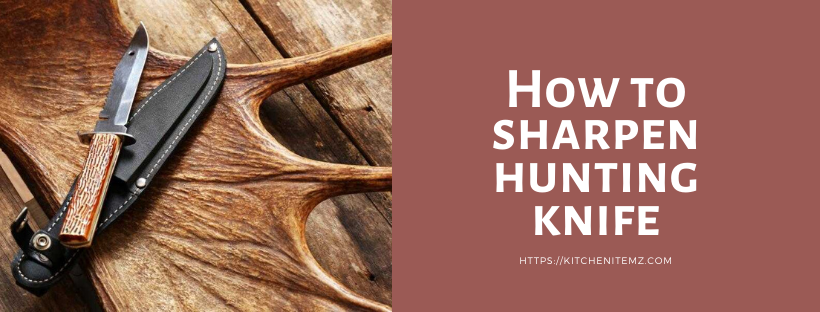
How to Sharpen Hunting Knife by the Best Way in 2024
How to sharpen hunting knife?
We can start with this famous statement of Abraham Lincoln
Give me 6 hours to chop down a tree and I will spend the first 4 sharpening the axe.
….………Abraham Lincoln
We can understand the importance of the sharpening of a hunting knife from the statement. A sharp hunting knife will make hunting easy. Hunting can be done with less effort if we have a sharp knife. A sharp knife is a safer knife. An edgeless knife poses the danger of cutting yourself when struggling with, and it would be torture to the animal you might be slaughtering.
What Kinds of Hunting Knives do You Want to Sharpen?
 Hunting knives do not necessarily mean a knife that is used for killing animals. Nowadays hunting knife takes many forms but optimized for skinning the animal, slicing and cutting up the meat rather than stabbing. Before knowing about the process of sharpening hunting knife we should know about the type of hunting knives.
Hunting knives do not necessarily mean a knife that is used for killing animals. Nowadays hunting knife takes many forms but optimized for skinning the animal, slicing and cutting up the meat rather than stabbing. Before knowing about the process of sharpening hunting knife we should know about the type of hunting knives.
Type of hunting knives
They are of mainly two types: Fixed-Blade Knife and Folding knife.
- Fixed-Blade Knife: If the animal you hunt is large; a fixed blade knife is often a better option for its strength and dependability.
- Folding knife: If the animal you hunt is small; a folding knife is often a better option. There are a few more advantages of folding knives. They are easy to carry and easy to conceal. They are also considered safer.
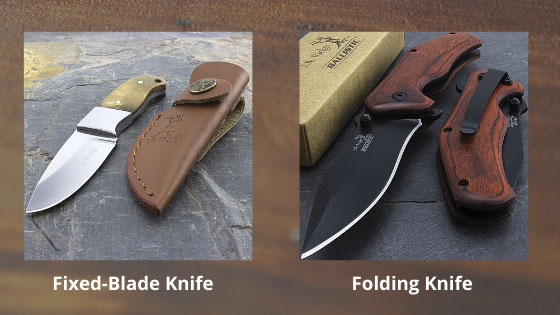
Type of knife blade
Based on uses, hunters use different types of blades of a knife, Clip Point, Drop Point, Skinning Blade, and Gut hook knife.
- Clip Point: This type of knife blade is thin. Their point is well-defined. The blade itself is relatively flat. Clip point knife is used for Skinning and Dressing.
- Drop Point: The drop point knife has a curved and thick blade. It’s used to dress the animal and skinning.
- Skinning Blade: These kinds of blades are specialized for skinning. Skin can be separated from the meat neatly and rapidly by using these kinds of blades.
- Gut hook knife: A major optional feature on a hunting knife is the gut hook. This is a unique type of blade that is used by huntsmen for field dressing.
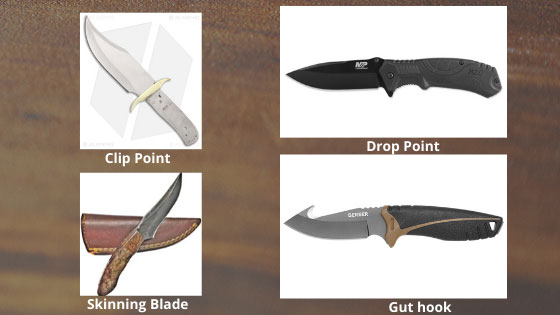
Sharpening a hunting knife
No hunter is fully prepared without a sharp knife. From skinning an animal to cutting up its meat, a sharp hunting knife is essential.
Some important points:
- For sharpening a knife perfectly, we need a skilled hand or quality sharpening tool
- The material used to make the knife should not be so hard or so soft. The knife should be hard enough to hold an edge, but soft enough to sharpen in a short time with a proficient hand or quality sharpening tool.
- While sharpening a knife we need to ensure proper sharpening angle. Proper sharpening angle can be ensured by using manual knife sharpener or electric sharpeners
Kinds of Stuff needed for supporting knife sharpening:
Before sharpening your hunting knife, you should manage some supporting stuff. Which will make our job fast and easy. Here are these supporting stuff for sharpening all hunting knives.
- Soft cloth (for cleaning): Before and while sharpening your hunting knife, you should clean the place or stone on which you want to sharpen the knife. Using a soft wet cloth is the best choice. After finishing the sharpening process, you can clean the blade by the cloth.
- Water: while sharpening hunting knives people use water as a liquid. Because there is no cost involved and it ensures very easy and efficient sharpening.
- Oil/liquid: Both methods are available to use oil and water on stone. Some sharpener performs well-using oil or liquid. But Using oil/liquid is expensive.
How to sharpen hunting knife?
There is more than one way to sharpen a hunting knife. They are explained below.
1. Using Whetstones:
Whetstones can be both natural and artificial made with artificial stones. Both usually come with a double-sided design, one side composed of coarse grit for sharpening and another side composed of fine grit for finishing and shaping.
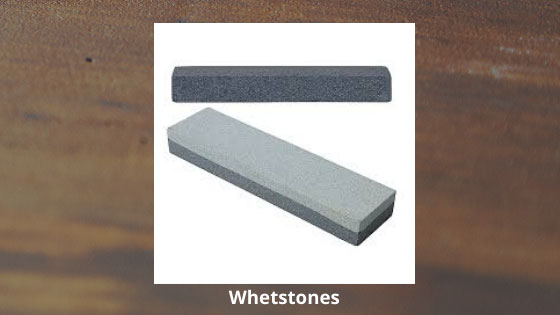 These are great for sharpening low- to mid-grade steel as well as carbon steel. People often use oil or water as a lubricant while sharpening to collect steel residue which helps sharpen the knife faster. But using a lubricant with whetstones is not mandatory. You can get whetstones in all sorts of shapes and sizes.
These are great for sharpening low- to mid-grade steel as well as carbon steel. People often use oil or water as a lubricant while sharpening to collect steel residue which helps sharpen the knife faster. But using a lubricant with whetstones is not mandatory. You can get whetstones in all sorts of shapes and sizes.
2. Using Diamond plates:
Diamond plates are the advancement of whetstones which are often worn after years of use. They are not only durable but also excellent for sharpening high-grade steel.
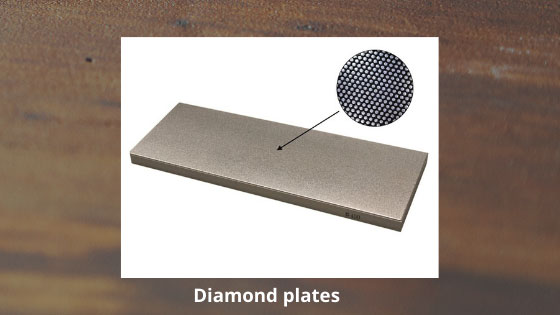 Diamond plates have a lot of variation. Their sizes are available from credit card to bench plate size. Different grades of grit are also available. A coarser grit is used to remove larger amounts of metal more rapidly. A finer grit is used to refine an edge and to remove the scratches of larger grits. There are two-sided plates with each side coated with a different grit.
Diamond plates have a lot of variation. Their sizes are available from credit card to bench plate size. Different grades of grit are also available. A coarser grit is used to remove larger amounts of metal more rapidly. A finer grit is used to refine an edge and to remove the scratches of larger grits. There are two-sided plates with each side coated with a different grit.
3.Using a Honing Rod (Sharpening Steel):
The honing rod isn’t normally used to sharpen a dull blade. Instead, honing rod often used to keep knives sharp intermediate use. Using a honing rod regularly delays the need to use a whetstone or a diamond plate. This is good to use honing rod, because whetstones and diamonds decay metal from the edge of your blade, reducing the knife’s lifespan. The less you use a whetstone, the longer your knives remain useable.
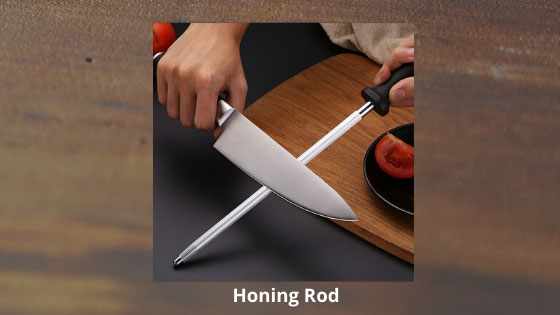 A honing rod re aligns the metal in a blade. Honing steel pushes the edge of the knife back to the center and straightens it. It corrects the edge without shaving off much. Unlike whetstones, it does not remove a significant amount of metal from the blade of the knife.
A honing rod re aligns the metal in a blade. Honing steel pushes the edge of the knife back to the center and straightens it. It corrects the edge without shaving off much. Unlike whetstones, it does not remove a significant amount of metal from the blade of the knife.
4.Using Pull-through sharpeners:
They are of a V-shaped design through which we pull the knife for sharpening.
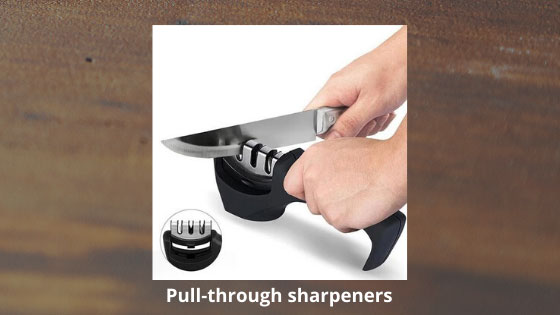 They are very easy to use, but maintaining a specific angle is tough. And they are not as effective as handheld stones. For this reason, they are better for home use rather than sharpening hunting knives.
They are very easy to use, but maintaining a specific angle is tough. And they are not as effective as handheld stones. For this reason, they are better for home use rather than sharpening hunting knives.
5.Using Electric Knife Sharpeners:
If you want to sharpen your knife fast, you need an electric sharpener. The electric sharpener comes with pre-set angles so you have to just run the knife through the slots.
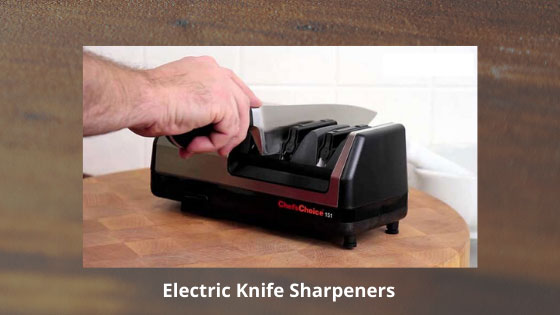 Most electric sharpeners have three slots for extreme sharpening, honing, and polishing respectively. Most electric sharpeners are made for home or kitchen knives. But some can handle hunting knives including serrated blades. Electric sharpeners are not as handheld stone sharpeners but they will sharp your knife and make it ready in under a minute or less.
Most electric sharpeners have three slots for extreme sharpening, honing, and polishing respectively. Most electric sharpeners are made for home or kitchen knives. But some can handle hunting knives including serrated blades. Electric sharpeners are not as handheld stone sharpeners but they will sharp your knife and make it ready in under a minute or less.
Which way of sharpening a hunting knife is best?
The best way of sharpening a hunting knife is by using Whetstones or Diamond plates.
The most important thing to keep in mind while sharpening a hunting knife using Whetstones or Diamond plates is to maintain the initial angle you started with. Different angles are required depending on the shape of the edge. A flat edge knife should be sharpened lying flat on the surface of the sharpener. Below are the steps you need to follow to sharpen a hunting knife using Whetstones or Diamond plates.
- Selecting an angle
Pick an angle to sharpen your knife. You can maintain angle in between 10 to 30-degree throughout the sharpening of any curved knives. The technique is more or less the same when working with a gut hook knife or with a serrated blade knife.
- Use oil or water
You should apply a small amount of lubricant (mineral oil) on your whetstone or diamond stone. You can also use water. It will make it easier for the blade of the knife to pass over the stone, as well as keep the steel shavings from stopping by the stone’s pores. Oil or water helps sharpen the knife much faster. While applying oil, use small drops and spread it all over the stone. Using too much oil will slow down the process, so you should ensure that you are using a thin film of oil.
- Start with the rough grit side of the stone
In general, diamond stones and whetstones each have different grits on either side. They have different purposes. The rough grit side is used to grind the steel down, and the fine grit side is used to sharpen or hone the knife. At first, you have to perform the grinding process. For grinding you have to use rough grit side of the stone.
If you are done with one side, flip the knife over and start working on the other side of the blade. Use the same number of strokes you made on the other side of the blade. It will ensure your knife’s even sharpening.
How will you know it’s time to flip to the other side of your blade? It can be felt by gently sliding your thumb on the opposite side of the sharpened area. If there is a burr, it’s time to sharpen the other side.
- Flip the sharpening stone to the finer grit
Flip the knife and begin sharpening the one side of the knife with the fine grit side of the stone. You have to be careful about hitting both sides of the knife with the finer grit. You must make the same number of strokes on each side. Otherwise, you might end up taking too much material from one side.
Using finer grit helps sharpen the edge further while smoothing over any uneven bumps made when using the coarse grit.
- Perform alternating swipes on the fine grit
In the end, sharpen one side of the knife with a single stroke, then immediately flip the knife and sharpen the other side. Do this several times for the best result. It will provide a perfect finishing.
After a thorough sharpening session, you can try cutting a sheet of paper to test whether the knife is sharp enough or not.
Conclusion
Most hunting knives are very expensive. A wrong sharpener and sharpening angle can damage a hunting knife’s edge. That’s why It’s really important to know the best way of sharpening a hunting knife.


